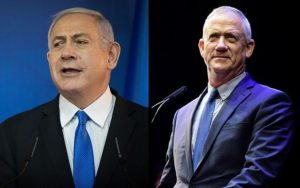Whoever Wins Israel’s Next Election Will Be a Right-winger

Prime Minister Benjamin Netanyahu, left, and Benny Gantz, right
Anshel Pfeffer writes in Haaretz, 20 January 2020, “The candidate’s photograph was carefully choreographed. As Kahol Lavan leader and prime ministerial aspirant Benny Gantz visited the Ir David archeological center in East Jerusalem, and said that it was “the root of our presence here,” he was flanked by three selected candidates. To his right was Yoaz Hendel, Benjamin Netanyahu’s former communications chief, right-wing heartthrob and currently a Kahol Lavan MK. To his left was Hili Troper, another MK, religious educator and writer, and for the past five years one of Gantz’s closest advisors.
Between the three stood a less-familiar face. Tehila Friedman-Nahlon, a veteran religious feminist activist. Number 36 on Kahol Lavan’s list, Friedman-Nahlon isn’t even an MK (yet) but she was essential to the photo. Gantz’s campaigners wanted him in East Jerusalem to be surrounded by religious-looking candidates. She isn’t the only religious woman in the party, but unlike MK Orit Farkash-Hacohen, Friedman-Nahlon covers her hair and her prominent red hat completed the picture perfectly.
Benny Gantz is being recast in this election as a right-leaning religious-friendly leader. Last week he visited a joint religious-secular high school and a liberal-religious women’s college. In the coming weeks, he will be in soft-core settlements as well. The more stridently secular and left-wing candidates in the party like Yair Lapid, his right-hand Ofer Shelah, and former Herzliya mayor (and Meretz member) Yael German, will get much less of the limelight. Instead we’ll hear how Kahol Lavan also plan to establish Israeli sovereignty in the Jordan Valley, and unlike Netanyahu, they just won’t talk about it. And when the Central Election Commission will debate Joint List MK Heba Yazbak’s social media posts glorifying Palestinian militants, Kahol Lavan will join the right-wing parties in voting to bar her from running.
“We are reversing our strategy from the last election,” says one senior Kahol Lavan member. “It’s cynical and blatant, but it’s what we have to do to win. You can expect to see a lot more of this kind of window-dressing with our religious candidates in the frame with Gantz.”
This is Kahol Lavan’s third campaign in twelve months, and in each of the elections it has run with a different strategy. In April 2019, it pushed hard on the need to become the “largest party” and won 35 seats, equal to Likud’s number. But in doing so, it hoovered up three-quarters of Labor seats which went from the 24 it won in 2015 (when it ran as Zionist Union), to just six. Five months later, in the September election, with nothing to gain from the left, and the fear that Labor and Meretz could go under, it ran on th
e promise of delivering a “secular national-unity government.” But this was ineffective, as Avigdor Lieberman’s Yisrael Beiteinu promised this as well and was more convincing in its attacks on the ultra-Orthodox parties. Kahol Lavan lost two seats (though Likud did even worse, losing three).
Now that Kahol Lavan has established itself as the largest party and continues to lead Likud in the polls by a small margin, its leaders and strategists are finally making a serious effort to do what they should have started on their first attempt last year, and target Likud’s soft-underbelly – the ten percent of Israeli voters who consider themselves right-wing but really don’t want Netanyahu to remain prime minister. A few of them already voted Kahol Lavan last year. Others stuck with Likud or voted Yisrael Beiteinu. Some stayed at home.
The wavering voters of this election are all on the soft-right. They don’t like any of the options on offer. They’re fed up with Netanyahu. They find Lieberman unpalatable, and they’ve been told that Gantz is a left-winger. As many as twelve seats could be in play. Five or six for them moving to Kahol Lavan would be enough for a sizable lead over Likud this time, and new coalition-building options after the election.
Netanyahu branded Gantz in the first election of 2019 as “weak left.” It didn’t entirely work, as the results showed. But the left-wing tag has remained with at least some right-wing voters.
Kahol Lavan needs to break sharply to the right, not just to attract the voters it needs, but also to make it easier for other right-wing parties like Yisrael Beiteinu, Naftali Bennett’s Hayamin Hahadash, Shas, and perhaps even a post-Netanyahu Likud to join a Gantz government.
Gantz has kept his views on the Israeli-Palestinian conflict sufficiently vague since becoming a civilian five years ago that he can still be convincingly portrayed as right-of-center, and present his party as a slightly more moderate and benign version of Likud, just without Netanyahu’s corruption. Kahol Lavan is a center-right party anyway – its hodgepodge list of candidates includes enough ex-Likudniks and even refugees from Yisrael Beiteinu and Habayit Hayehudi to justify that label.
To soften the secular image, Kahol Lavan will remind voters that Gantz spent the first eight years of his schooling in religious institutions, including a couple of years at Or Etzyon, the yeshiva headed by Rabbi Chaim Drukman, the spiritual leader of religious Zionism. In many ways, he is much closer to the religious community than Netanyahu.
Either way, whoever wins this election, will be a right-winger.” This article is printed in its entirety.
